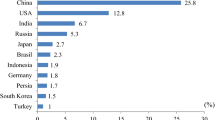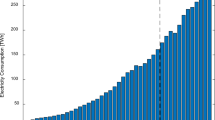Abstract
This paper studies the performance of an artificial neural network (ANN) with teaching–learning-based optimization (TLBO) for modeling electric energy demand (EED) in Turkey. The ANN with TLBO (ANN-TLBO) was compared to the ANN with backpropagation (ANN-BP) and the ANN with artificial bee colony algorithm (ANN-ABC) models. Gross domestic product, population, import, and export were selected as independent variables in the models. The results reveal that the ANN-TLBO models perform better than the ANN-BP and ANN-ABC models in EED estimation. The average root-mean-square error of the ANN-BP and ANN-ABC models was decreased by 42.3 and 39.3 % using the ANN-TLBO model, respectively. Different scenarios have been studied over a projected 6-year period, from 2013 to 2018, to forecast Turkey’s EED. The results of the proposed model give excellent clues with regards to its use in future energy studies.




Similar content being viewed by others
References
Cao Y, Pawlowski A (2013) Biomass as an answer to sustainable energy opportunity versus challenge. Environ Prot Eng 39:153–161
Kankal M, Bayram A, Uzlu E, Satılmış U (2014) Assessment of hydropower and multi-dam power projects in Turkey. Renew Energy 68:118–133
Özdemir A (2013) Demand, supply and partial equilibrium analysis of Turkish electricity energy pricing. Master Thesis, Middle East Technical University Graduate School of Applied Mathematics, Ankara, Turkey
Azadeh A, Taghipour M, Asadzadeh SM, Abdollahi M (2014) Artificial immune simulation for improved forecasting of electricity consumption with random variations. Electric Power Energy Syst 55:205–224
Ozturk HK, Ceylan H, Canyurt OE, Hepbasli A (2005) Electricity estimation using genetic algorithm approach: a case study of Turkey. Energy 30:1003–1012
Yumurtaci Z, Asmaz E (2004) Electric energy demand of Turkey for the year 2050. Energy Sources 36:1157–1164
Hamzacebi C (2007) Forecasting of Turkey’s net electricity energy consumption on sectoral bases. Energy Policy 35:2009–2016
Kavaklıoğlu K, Ceylan H, Ozturk HK, Canyurt OE (2009) Modeling and prediction of Turkey’s electricity consumption using artificial neural networks. Energy Convers Manag 50:2719–2727
Akay D, Atak M (2007) Grey prediction with rolling mechanism for electricity demand forecasting of Turkey. Energy 32:1670–1675
Toksarı MD (2009) Estimating the net electricity energy generation and demand using the ant colony optimization approach: case of Turkey. Energy Policy 37:1181–1187
Kucukali S, Baris K (2010) Turkey’s short-term gross annual electricity demand forecast by fuzzy logic approach. Energy Policy 38:2438–2445
Dilaver Z, Hunt LC (2011) Modelling and forecasting Turkish residential electricity demand. Energy Policy 39:3117–3127
Günay ME (2016) Forecasting annual gross electricity demand by artificial neural networks using predicted values of socio-economic indicators and climatic conditions: case of Turkey. Energy Policy 90:92–101
Kavaklioglu K (2014) Robust electricity consumption modeling of Turkey using singular value decomposition. Electric Power Energy Syst 54:268–276
Bilgili M (2009) Estimation of net electricity consumption of Turkey. J Therm Sci Technol 29:89–98
Şişman B, Elgün MN (2013) A comparison of decision making models and electricity energy demand forecasting for Turkey. In: International conference on economic and social studies (ICESoS’2013), 10–11 May, 2013, Sarajevo
Gürbüz F, Öztürk C, Pardalos P (2013) Prediction of electricity energy consumption of Turkey via artificial bee colony: a case study. Energy Syst 4:289–300
Oğcu G, Demirel OF, Zaim S (2012) Forecasting electricity consumption with neural networks and support vector regression. Proc Soc Behav Sci 58:1576–1585
Boran K (2014) The box Jenkins approach to forecast net electricity consumption in Turkey. Energy Sources Part A Recovery Util Environ Effects 36:515–524
Hamzaçebi C, Kutay F (2004) Forecasting of Turkey’s electricity energy consumption using ANN up to 2010 year. Gazi Univ J Eng Arch Fac 19:227–233
Hamzaçebi C, Es HA (2014) Forecasting the annual electricity consumption using ANN an optimized grey model. Energy 70:165–171
Kaytez F, Taplamacioglu MC, Cam E, Hardalac F (2015) Forecasting electricity consumption: a comparison of regression analysis, neural networks and least squares support vector machines. Electr Power Energy Syst 67:431–438
Tutun S, Chou CA, Canıyılmaz E (2015) A new forecasting for volatile behavior in net electricity consumption: a case study in Turkey. Energy 93:2406–2422
Erdogdu E (2007) Electricity demand analysis using cointegration and ARIMA modeling: a case study of Turkey. Energy Policy 35:1129–1146
Kıran MS, Özceylan E, Gündüz M, Paksoy T (2012) Swarm intelligence approaches to estimate electricity energy demand in Turkey. Knowl Based Syst 36:93–103
Amina M, Kodogiannis VS, Petrounias I, Tomtsis D (2012) A hybrid intelligent approach for prediction of electricity consumption. Electr Power Energy Syst 36:99–108
Sajadi SM, Asadzadeh SM, Dalfard VM, Asli MN, Shirkouhi SN (2013) A new adaptive fuzzy inference system for electricity consumption forecasting with hike in prices. Neural Comput Appl 23:2405–2416
Arkadani FJ, Ardehali MM (2014) Long-term electrical energy consumption forecasting for develo** and developed economies based on different optimized models and historical data types. Energy 65:452–461
Arkadani FJ, Ardehali MM (2014) Novel effects of demand side management data on accuracy of electrical energy consumption modeling and long-term forecasting. Energy Convers Manag 78:745–752
Suganthi L, Samuel AA (2012) Energy model for demand forecasting—a review. Renew Sustain Energy Rev 16:1223–1240
Azadeh A, Ghaderi SF, Sohrabkhani S (2008) A simulated-based neural network algorithm for forecasting electrical energy consumption in Iran. Energy Policy 36:2637–2644
Rumelhart DE, Hinton GE, Williams RJ (1986) Learning representations by back-propagating errors. Nature 323:533–536
Karaboga D (2005) An idea based on honey bee swarm for numerical optimization. Technical Report-TR06. Erciyes University Engineering Faculty Computer Engineering Department
Uzlu E, Akpınar A, Öztürk HT, Nacar S, Kankal M (2014) Estimates of hydroelectric generation using neural networks with artificial bee colony algorithm for Turkey. Energy 69:638–647
Rao RV, Savsani VJ, Vakharia DP (2011) Teaching–learning based optimization: a novel method for constrained mechanical design optimization problems. Comput Aided Des 43:303–315
Safarinejadian B, Gharibzadeh M, Rakhshan M (2014) An optimized model of electricity price forecasting in the electricity market based on fuzzy timeseries. Syst Sci Control Eng Open Access J 2:677–683
Dede T (2013) Optimum design of grillage structures to LRFD–AISC with teaching–learning based optimization. Struct Multidiscip Optim 48:955–964
Togan V (2013) Design of pin jointed structures using teaching–learning based optimization. Struct Eng Mech 47:209–225
Togan V (2012) Design of planar steel frames using teaching–learning based optimization. Eng Struct 34:225–232
Uzlu E, Kankal M, Akpınar A, Dede T (2014) Estimates of energy consumption in Turkey using neural networks with the teaching–learning-based optimization algorithm. Energy 7:295–303
Turkish Statistical Institute (TURKSAT). Population and demography, population statistics. http://www.turkstat.gov.tr/UstMenu.do?metod=temelist. Accessed 06 June 2013
Turkish Electricity Transmission Company (TEIAS). Monthly distribution of Turkey’s gross electricity generation by the imports-exports and gross demand. http://www.teias.gov.tr/TürkiyeElektrikİstatistikleri/istatistik2011/istatistik%202011.htm. Accessed 08 May 2013
International Monetary Fund (IMF) (2009) World economic outlook database. Washington. http://www.imf.org/external/pubs/ft/weo/2009/01/weodata/weorept.aspx?sy=1980&ey=2014&scsm=1&ssd=1&sort=country&ds=.&br=1&c=186&s=NGDPD&grp=0&a=&pr1.x=37&pr1.y=11. Accessed 05 June 2013
Republic of Turkey Ministry of Development. International economic indicators report http://www.kalkinma.gov.tr/Lists/Uluslar%20Aras%20Ekonomik%20Gstergeler/Attachments/9/Uluslararası%20Ekonomik%20Göstergeler-2013.pdf. Accessed 04 June 2013
Republic of Turkey Ministry of Development. Tenth Development Plan [in Turkish]. http://www.kalkinma.gov.tr/DocObjects/view/15051/Onuncu_Kalk%C4%B1nma_Plan%C4%B1_(TBMM’ye_sevkedilen_Taslak).pdf. Accessed 05 June 2013
TEIAS (Turkish Electricity Transmission Company). Turkey’s electric energy 10 year production capacity projection (2012–2021). See also: http://www.epdk.gov.tr/documents/elektrik/rapor_yayin/Elk_Yayin_Uretim_Kapasite_Projeksiyonu_2012_2021.pdf. Accessed 06 July 2013 (in Turkish)
TEIAS (Turkish Electricity Transmission Company). Turkey’s electric energy 5 year production capacity projection (2014–2018). See also: http://www.teias.gov.tr/YayinRapor/apk/projeksiyon/KAPASITEPROJEKSIYONU2014.pdf. Accessed 12 Apr 2016 (in Turkish)
Melikoglu M (2013) Hydropower in Turkey: analysis in the view of vision 2023. Renew Sustain Energy Rev 25:503–510
Author information
Authors and Affiliations
Corresponding author
Additional information
This study is dedicated to the memory of the late Assoc. Prof. Dr. Murat İhsan KÖMÜRCÜ, who passed away in February 2013.
Rights and permissions
About this article
Cite this article
Kankal, M., Uzlu, E. Neural network approach with teaching–learning-based optimization for modeling and forecasting long-term electric energy demand in Turkey. Neural Comput & Applic 28 (Suppl 1), 737–747 (2017). https://doi.org/10.1007/s00521-016-2409-2
Received:
Accepted:
Published:
Issue Date:
DOI: https://doi.org/10.1007/s00521-016-2409-2




